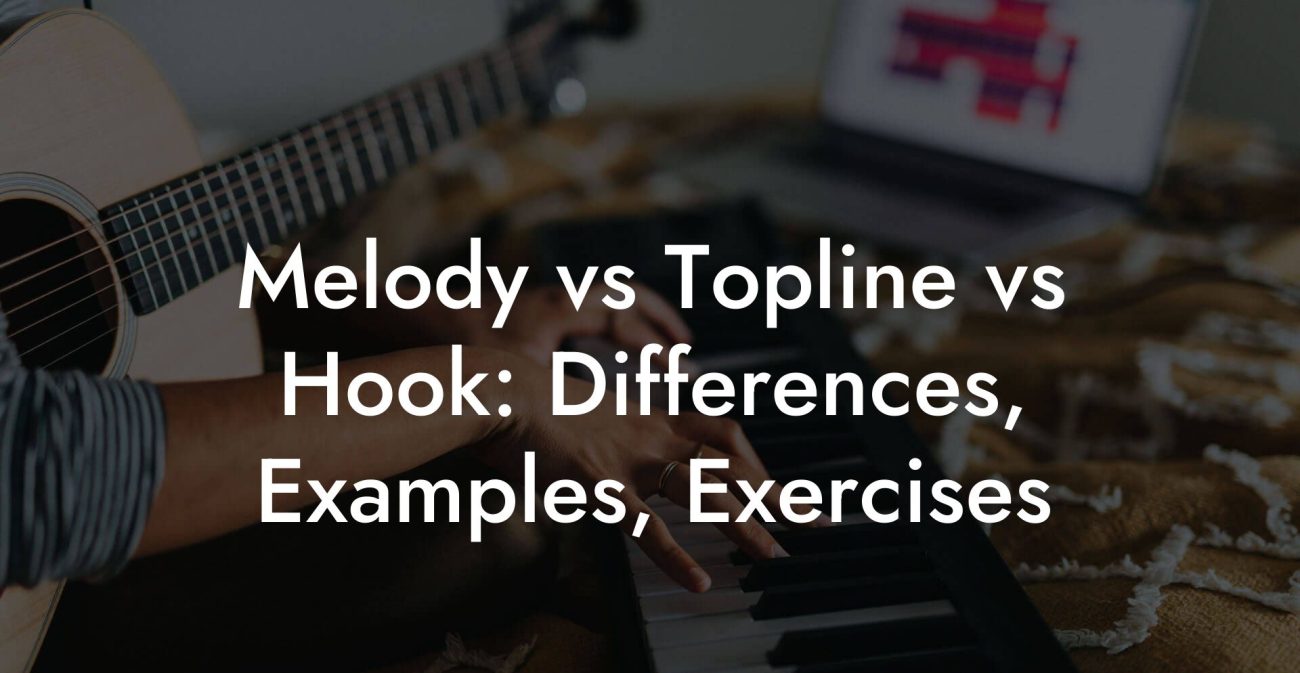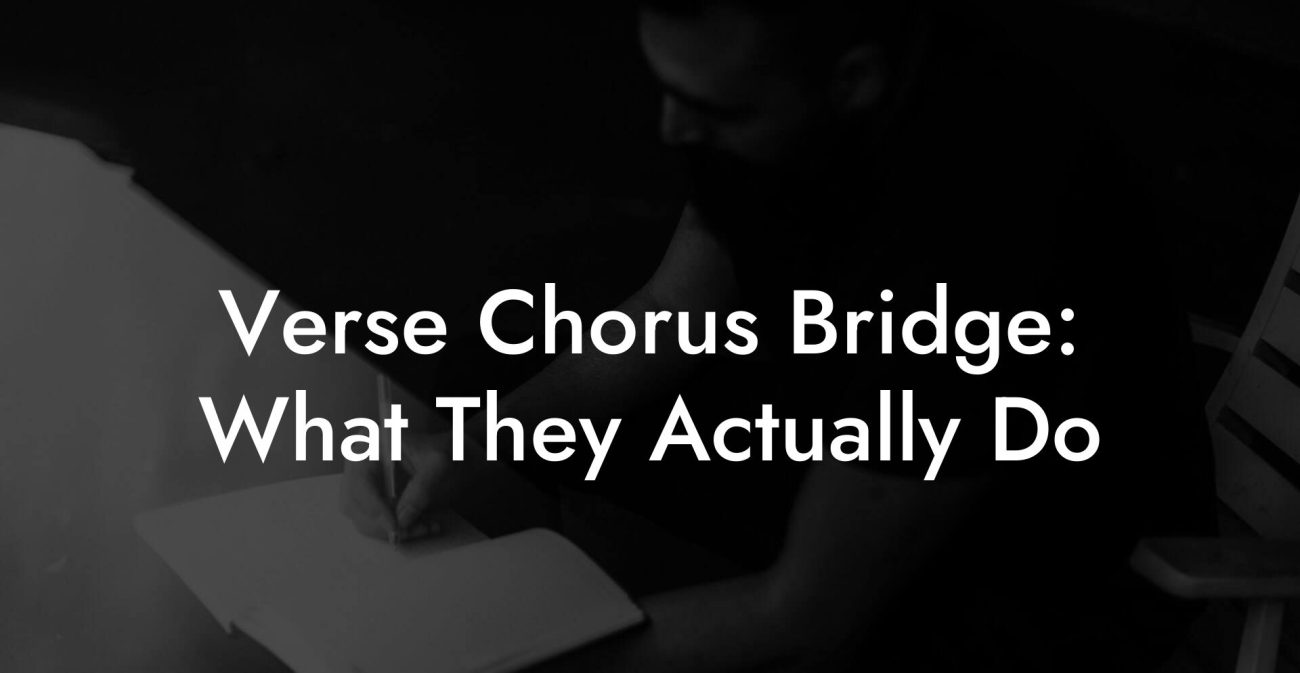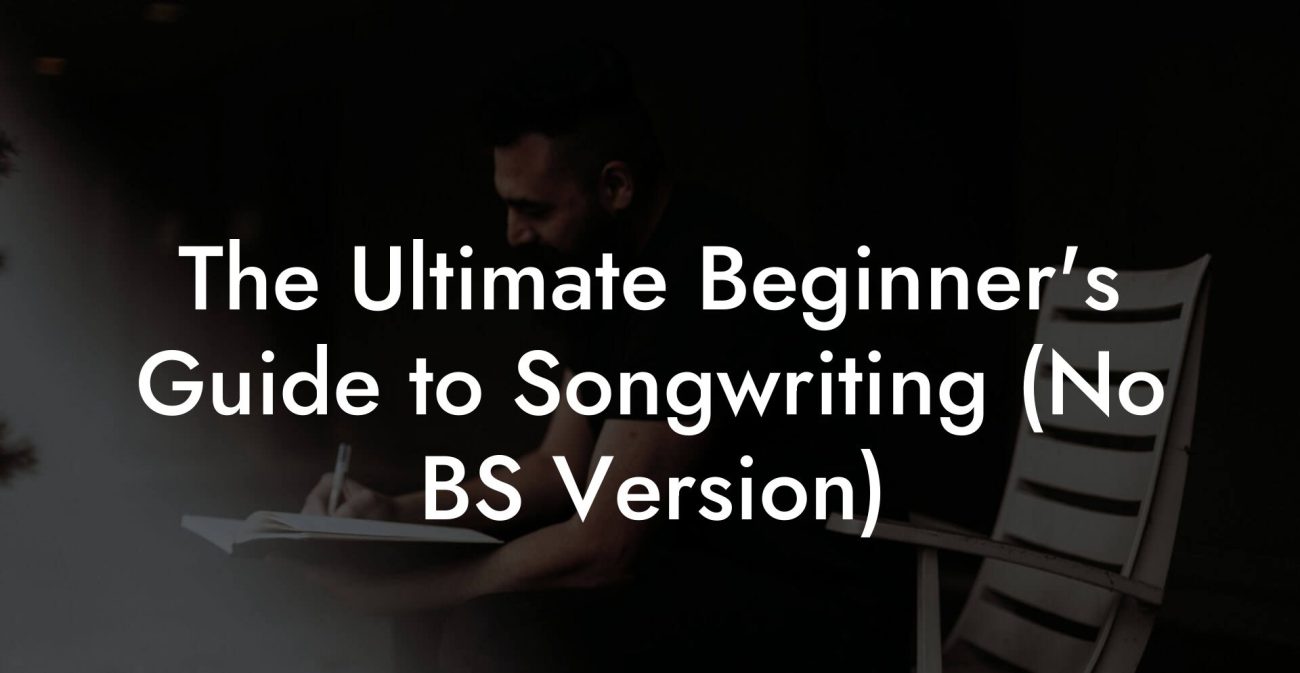Songwriting Advice
Prosody for People Who Hate Poetry

Prosody is the art of making your words behave in music. If you flinch at poetic metaphors, if you write lyrics that feel like someone read a vague fortune cookie into your melody, you are in the right place. This is a practical guide that says the same things poets mean without the weird perfume and long sighs. You will learn what to listen for, what to change, and how to make listeners sing your title back at a bar or in a shower video on an app.
Quick Interruption: Ever wondered how huge artists end up fighting for their own songs? The answer is in the fine print. Learn the lines that protect you. Own your masters. Keep royalties. Keep playing shows without moving back in with Mom. Find out more →
Quick Links to Useful Sections
- What is prosody and why you should care
- Quick example
- Core components of prosody
- Stress
- Syllable count and density
- Vowel shape
- Consonant timing
- Phrasing and breath
- Word length and monosyllables versus multisyllables
- Real life scenarios that show prosody matters
- Scenario 1: The viral hook for a fifteen second clip
- Scenario 2: A rap verse that feels off in the pocket
- Scenario 3: A ballad where the chorus feels like a whisper
- Common prosody mistakes and how to fix them
- Mistake: title buried inside a busy phrase
- Mistake: wrong stress
- Mistake: vowel mismatch on a long note
- Mistake: consonant crunch at the note attack
- Prosody rules you can use every time
- Rule 1: Align stressed syllables with strong beats
- Rule 2: Put your title on a long comfortable vowel
- Rule 3: Match syllable density to tempo and groove
- Rule 4: Avoid stacking hard consonants before sustained notes
- Rule 5: Use natural punctuation to guide breath
- Rule 6: Test prosody by speaking the line and tapping the tempo
- Rule 7: Use monosyllable punch for front loaded hooks
- Rule 8: Let the hook repeat with tiny changes for interest
- Practical exercises and drills
- Exercise 1: The Talk Tap Drill
- Exercise 2: Vowel audition
- Exercise 3: Consonant timing game
- Exercise 4: The one minute rewrite
- Exercise 5: Singer swap
- Before and after edits you can steal
- Example 1
- Example 2
- Example 3
- Prosody across genres
- Pop
- R and B
- Rap
- Indie and folk
- Electronic and dance
- Recording and production tips that help prosody
- Isolation takes
- Timing nudges
- Automation for clarity
- Comping and layering
- How to coach singers on prosody
- Editing workflow for prosody friendly songs
- When to break the rules
- Advanced tools and terms explained
- Checklist to run before you finalize a song
- Action plan you can use today
- Prosody FAQ
Everything here is written for busy musicians who want clear results. We will cover the essentials of stress, syllables, vowel shape, consonant timing, phrasing, breath, and editing. There are rules and there are hacks. There are drills you can do in five minutes and a checklist for final passes. We explain any jargon. We give real life scenarios so you can picture this working on the next topline you toss into a demo. If you hate poetry because it feels coy or pretentious, welcome. This is prosody for people who want songs that land.
What is prosody and why you should care
Prosody is how words sit on music. It is the match between natural spoken stress and musical rhythm. Good prosody makes phrases feel inevitable and honest. Bad prosody makes great lines sound awkward or gets swallowed by the beat.
Think of prosody like fit. A lyric with bad prosody is wearing shoes two sizes too big. You trip on the beats. A lyric with good prosody fits like a glove. The music becomes the body language of the line. The listener does not notice the mechanics. They only feel the emotion.
Quick example
Say the line out loud like text to a friend. Then sing it on the melody. If the natural stresses in speech fall on weak musical beats or on short unimportant notes, the line will sound off. Good prosody puts the strong words on strong beats and gives long syllables long notes.
Core components of prosody
Prosody is a stack of parts. Fixing one often improves the rest. Learn them, then practice them.
Stress
Stress is which syllables in a word feel heavier in normal speech. For example the word record changes stress depending on whether it is a noun or a verb. As a noun it is REcord. As a verb it is reCORD. In songwriting you must decide which stress you mean and place it on a stronger musical beat. If you put the wrong stress on the wrong beat you will feel friction even if you can not name it.
Syllable count and density
This is how many syllables you are asking the melody to carry in a bar. If your melody gives one long note to a bar and your lyric is trying to cram five syllables there the line will either be rushed or the lyric will be chopped. Match syllable density to the rhythm. You can fix extremes by changing words or changing note lengths.
Vowel shape
Open vowels sing better on sustained notes. Vowels are the sounds a e i o u and their variants. Vowels like ah or oh are comfortable on high sustained notes. Vowels like ee are brighter and can be painful if held too long at top register. When you place your title on a long high note pick a vowel that your singer can hold without cracking.
Consonant timing
Consonants interrupt sound. If a line ends with a hard consonant like k or t right before a held note you will need to fit the consonant into the break or risk clipping the note. Plan for consonant releases and places where the voice needs air. Sometimes swapping a final consonant for a softer word fixes the groove.
Phrasing and breath
Humans need air. Phrasing is where to breathe. Choose natural breath points that do not break the thought. If your singer has to breathe awkwardly in the middle of a sentence the performance collapses. Write with natural punctuation and record with the breath in mind.
Word length and monosyllables versus multisyllables
Short words land harder. Long words can carry melody but they require supportive vowels and clear stress. A title that is five syllables is harder to sing as a chant. Two syllable titles often win for mass recall unless the phrase is clever and melodic.
Real life scenarios that show prosody matters
Here are common songwriter moments and how prosody saves you.
Scenario 1: The viral hook for a fifteen second clip
You want the phrase to be repeatable in a fifteen second clip on a social app. That means the title should be short, placed on a strong beat, and use an open vowel that is easy to sing across voice types. If your title has a weird stress pattern it will lose on first listen. Make it simple and punchy.
Scenario 2: A rap verse that feels off in the pocket
Rappers live in stress and rhythm. If your multisyllabic rhymes ignore which syllable carries the weight the flow will stumble. Map the stressed syllable of each word to a strong beat. If the natural stress does not fit change the word or reorder the phrase. The pocket is sacred.
Scenario 3: A ballad where the chorus feels like a whisper
Ballads rely on vowel shape and vowel length. If your chorus has the emotional line on a weak vowel or hidden under a lot of consonants the release will not hit. Move the main idea to an open vowel and let the harmony breathe behind it.
Common prosody mistakes and how to fix them
Here are mistakes I see in demos and quick fixes you can apply.
Mistake: title buried inside a busy phrase
Before: I cannot find the words to tell you that I am leaving tomorrow.
Why it fails: The title idea is long and hidden. The stress pattern is scattered.
After: I am leaving tomorrow. This says the same thing with a clear stress and a singable rhythm. Put the title on a strong beat and give it breathing room.
Mistake: wrong stress
Before: I will reCORD this memory for you. The music wanted REcord as a noun.
Why it fails: The natural stress of the intended meaning was on the wrong syllable compared with the melody.
After: I keep your old vinyl record in my room. Now the stress is on the noun and matches the melodic emphasis.
Mistake: vowel mismatch on a long note
Before: I will be so HEEless on the top note. Vowel ee at top register is shrill for many voices.
Fix: Change to I will be so helpless. Helpless contains an ah vowel on the long note and sits better on top pitches.
Mistake: consonant crunch at the note attack
Before: Cut the last consonant on the downbeat and your singer starts late because of the k.
Fix: Use a softer word before the hold or move the consonant to the end of a short note and the vowel to the long note.
Prosody rules you can use every time
These are not laws of nature. They are reliable shortcuts. Start with these and break them only when you know why you are breaking them.
Rule 1: Align stressed syllables with strong beats
Find the natural stress of the word and put it on a downbeat or a long note. If the melody cannot be changed, change the word. For example trade a word with a weak stress for a synonym with a stronger stress pattern.
Rule 2: Put your title on a long comfortable vowel
Pick vowels that sing. If the chorus holds the title on a long note choose a vowel like ah or oh or an open o. Avoid high front vowels like ee on long strained notes at the top of the range.
Rule 3: Match syllable density to tempo and groove
At fast tempos call for fewer syllables per bar. At slow tempos you can afford more. If your verse uses a lot of quick words keep the chorus sparse. If the verse is spare you can make the chorus busier for contrast.
Rule 4: Avoid stacking hard consonants before sustained notes
Soft endings give singers time to move to the next phrase. Replace a word that ends in a hard stop with a softer alternative or restructure the phrase so the consonant is on a short note.
Rule 5: Use natural punctuation to guide breath
Write like you speak and mark the places where you and your singer will breathe. A comma or a short rest in the melody is permission to draw air. If the phrase is one long sprint consider adding a short breath or splitting the line into two parts.
Rule 6: Test prosody by speaking the line and tapping the tempo
Say the line at normal speed while someone taps the beat. If the natural stress falls on different beats than the tap you have work to do. Rephrase until they line up or move the melody to suit the natural speech stress.
Rule 7: Use monosyllable punch for front loaded hooks
Simple one syllable words hit harder in single moment chants. Think of title phrases that are short and rhythmic. They are easier for a crowd to sing back and easier for platforms to clip into a repeatable moment.
Rule 8: Let the hook repeat with tiny changes for interest
Repeat the hook like a slogan. After the second repeat change a tiny word to reveal a twist. The repetition builds memory. The change builds curiosity.
Practical exercises and drills
Practice like a musician. These exercises take five to thirty minutes and give immediate feedback.
Exercise 1: The Talk Tap Drill
- Choose a lyric line you want to test.
- Tap the tempo on a surface with your index finger.
- Say the line naturally over the tapping.
- Mark which words landed on your taps and which fell between taps.
- If a stressed word is off the tap reword the line or retime the melody.
This drill forces you to hear the difference between natural speech rhythm and musical rhythm quickly.
Exercise 2: Vowel audition
- Take your chorus line and sing it on vowels only like ah ah ah.
- Try the line on ah oh oo and eh.
- Record briefly and listen back. Pick the vowel that sounds best on the melody.
- Replace the lyric vowel if needed. Change words to match the best vowel if the singer can not hold the original.
Vowel choice often solves the problem before you touch the words.
Exercise 3: Consonant timing game
- Write a short phrase with a final hard consonant.
- Sing the phrase and mark where the consonant falls.
- Try swapping to a synonym with a softer ending. Sing again.
- Decide which version gives a cleaner attack into the following held note.
Exercise 4: The one minute rewrite
- Set a timer for one minute.
- Take a line you like but which feels awkward on the tune.
- Rewrite the line in three different ways that change stress, syllable count, vowel shape, or word order.
- Sing each version. Pick the one that sits easiest.
Exercise 5: Singer swap
Have someone else sing the line. A different voice will reveal prosody problems you cannot hear in your own range. If the other person struggles the problem is likely prosodic rather than technical.
Before and after edits you can steal
Below are concrete rewrites to show what prosody editing looks like in practice.
Example 1
Before: I am trying to say the things that I have never shown you.
After: I never showed you what I mean. The after version shortens the title and places the verb show on the stress. It moves a long list into a simpler bite that sits on the beat.
Example 2
Before: Baby do not make me go and feel the loneliness again tonight.
After: Baby do not make me feel alone tonight. The after version reduces syllables and puts the emotion word alone on a long vowel for maximum impact.
Example 3
Before: In the morning when the sunlight falls across the counter and I think of you.
After: Morning light hits the counter. I think of you. Breaking the long sentence into two lines gives space for breath and lets the stress land on morning and think.
Prosody across genres
Different genres use prosody in different ways. Know the rules of the game for the style you write in.
Pop
Pop leans on clear title placement and singable vowels. Keep chorus titles short and repeatable. Use open vowels on long notes. Avoid multi syllable titles unless the melody supports them. Make the chorus feel like a tagline.
R and B
R and B often stretches vowels and plays with timing. It tolerates off beat stress for emotional effect. Still respect breath. If you are using rubato give the singer a strong anchor line that comes back to tempo so the listener can hold on.
Rap
Rap is about stress and consonant sound. Multisyllabic chains must land stressed syllables on strong beats. Internal rhythm matters more than vowel shape. Use syncopation deliberately and map multisyllabic words to the beat grid while keeping the natural speech stress in mind.
Indie and folk
These styles sometimes favor conversational prosody. The voice can sit inside the rhythm like a narrator. Still mark breath points and avoid hiding the emotional word behind an awkward musical placement. The goal is vividness with a natural cadence.
Electronic and dance
Dance tracks often repeat small hooks and rely on syllable consonance more than complex lines. Use short strong words and place them on the drop. Choose vowel sounds that cut through the mix when side chain compression is active.
Recording and production tips that help prosody
Prosody is partly writing and partly mixing. Production choices can hide or reveal prosodic problems.
Isolation takes
Record the vocal in clean takes so you can judge prosody without bleed from instruments. If the singer is fighting the backing arrangement the performance will look like a prosody problem when it might be a mixing choice.
Timing nudges
It is okay to nudge a syllable forward or back in the edit to fix stress alignment. Move small bits of audio, not whole words. The ear notices micro timing more than a big shift. Keep nudges tasteful and listen for natural speech feeling.
Automation for clarity
Automate volume and EQ to make the stress words pop. A small boost on the stressed syllable can help the listener latch the phrase without changing the lyric itself.
Comping and layering
Use doubles to reinforce a weak phrase. A subtle double an octave below or a close harmony on the stressed word can make the chorus stick without rewriting the line.
How to coach singers on prosody
Singer coaching is about guiding natural speech into music.
- Ask the singer to speak the line as if texting a friend. Hear where their stress falls.
- Then have them sing the line on a steady click or simple chord. If their spoken stress falls off the beat ask them to exaggerate the stress into the beat.
- Use small rhythmic taps to indicate where the heavy word should land.
- Record both spoken and sung versions. Play them back. The speaker will usually trust the spoken version as more truthful.
Helping the singer find a natural fit is often faster than rewriting the lyric around the melody. Both options are valid. Choose the one that keeps emotional truth intact.
Editing workflow for prosody friendly songs
- Lock the melody. If the melody is still changing do prosody edits later.
- Speak every line and mark stressed syllables.
- Tap the tempo while marking the downbeats. Align stressed syllables with downbeats where you want impact.
- Run the noun and verb test. Make sure the emotional noun or action verb lands on a strong beat.
- Check vowel shapes on long notes using the vowel audition exercise.
- Fix consonant timing by replacing or moving words where necessary.
- Test with another voice. Record a quick swap to make sure the prosody survives different timbres and ranges.
- Make small mix moves like automation and doubles to reinforce the stress without changing the lyric.
When to break the rules
Rules exist so you can break them tastefully. You might place an unstressed syllable on a strong beat for irony. You might hide a title to reveal it later. When you break prosody rules you must have a reason. The reason must be emotional or narrative. Otherwise you are choosing awkward for no benefit.
If you choose to break a rule record the line both ways. Compare the emotional effect. If the break serves the song keep it. If it feels like a mistake undo it.
Advanced tools and terms explained
Quick definitions for terms you might see in other articles.
- IPA means International Phonetic Alphabet. It is a system that shows exact sound. You do not need to learn it to fix prosody but it helps if you want to see vowel sounds precisely.
- BPM means beats per minute. It tells you the speed of the song. High BPM calls for fewer syllables per bar if you want clarity.
- MIDI stands for Musical Instrument Digital Interface. Producers use it to move notes around. You can nudge lyric timing in a MIDI grid as a reference for vocal timing.
- Rubato is expressive timing that stretches or compresses tempo for feeling. It can be used by singers but watch the backing. If you use rubato give other musicians a cue track.
Checklist to run before you finalize a song
- Speak every lyric and mark natural stresses.
- Tap the tempo and align stresses with beats where you want impact.
- Put the title on an open vowel and a long note if it is a sung hook.
- Check for hard consonants before held notes and soften if needed.
- Verify breath points with the singer and record both spoken and sung takes.
- Swap voices or have a friend sing the line to check universality.
- Listen on small speakers and headphones to ensure clarity at various volumes.
- Ask one honest person which line stuck and why. If they cannot name the line consider another pass.
Action plan you can use today
- Pick your chorus line. Say it out loud twice like you are texting a friend.
- Tap the tempo with your foot or finger. Say the line on the taps.
- If the stressed word lands off the tap rewrite the line into three alternate versions that shift stress or shorten syllables. Use one minute per rewrite.
- Sing the three versions on the melody and pick the cleanest one. Record each take quickly.
- Do a vowel audition on the chosen version and swap to the best vowel if needed.
- Record a clean demo. Ask three people which line they remember. If none of them name the title return to step one and shorten the title.
Prosody FAQ
What if I like the lyric but the stress does not fit the melody
You have options. Change the melody if it serves the song. Change the word order to shift stress. Swap synonyms that carry the stress where you need it. Or coach the singer to slightly alter timing so the spoken stress moves to the beat. The fastest fix is often a small word swap.
Do I need to learn music theory to do this
No. Prosody relies on listening and speech awareness more than formal theory. Basic music terms help but you do not need advanced theory. Learn beats per measure and where the downbeats are. That is enough for most prosody work.
How do I pick the best vowel for a high note
Sing the melody on vowels ah oh oo and eh. Listen for the smoothest and strongest sound that does not strain. If you do not want to change the word choose a nearby synonym with a friendlier vowel shape.
Can production fix bad prosody
Production can hide small issues with automation and layering but it cannot make a line that fights the beat feel natural for everyone. Fix the writing first, then use production to reinforce. If you rely on mix tricks to mask fundamental prosody problems you will hear the issues at lower volumes and live.
How do I make a phrase singable for different voice types
Choose vowels and note shapes that are comfortable across ranges. Avoid extreme top notes with closed vowels. Test with different singers. If the line proves fragile ask whether the twist of that line is worth limiting who can sing it.





